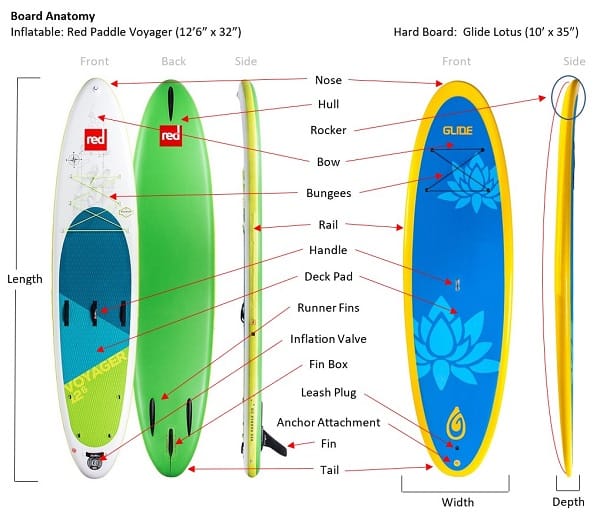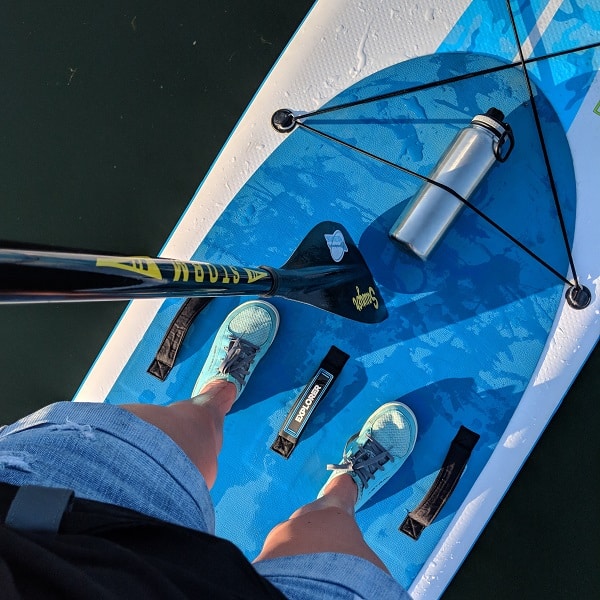Paddleboard Basics
Have you ever heard someone ask about the “fin” or say “grab onto the rail” and not know what that meant? How about “face the nose” or “cross the bow”? And then there’s leashes and bungees… what are those for? Well, if you don’t know, that’s ok, that is what this blog is all about – paddleboard basics!
Learning about the board is the starting point, your foundation for getting into the sport. Knowing the basics is important, especially if you are looking to purchase your first stand-up paddleboard (SUP). Or even if you are just out adventuring with friends on the river, it is helpful to understand these features. Not only could it enhance your experience and safety, but also your enjoyment. There’s more to these boards than you might think.
If you are wanting a more hands-on approach, we have our Intro to SUP class. If you haven’t taken this class, we highly recommend it! It is where the rubber meets the road as we review the basics and paddleboard features but also build on that foundation by applying that information on the water. You will learn about the equipment, SUP safety, proper paddling techniques, maneuvering, recovery, and helpful tips. It is a great way to learn the basics of SUP in a fun, group setting.
For this blog, we will discuss the basics of paddleboards – anatomy, general concepts, and key features. We will cover board types and much more in depth in our upcoming blogs – differences between inflatable boards vs. traditional hard boards and what to look for when purchasing your first paddleboard.

Let’s start with board anatomy!
Displayed above are common terms and features associated with two types of boards we carry in our store. This image highlights the location of these features but also notes differences between each board as one is an inflatable and the other is a traditional hard board. Also displayed above are some general concepts of size and shape.
Size and shape play a large role in how the board performs in the water.
Length of the board refers to how long it is from nose to tail. Longer boards are generally faster while shorter boards maneuver easier.
Width measures rail to rail at the widest point (typically at the handle). Wider is typically more stable but less maneuverable.
Depth refers to the thickness of the board – more depth means more volume.
Volume is a combination of size (length, width, depth) and shape determining the buoyancy of the board measured in liters. In other words, the more volume the board has, the more weight it can support.
Key Features:
- Handle: this is the balance point of the board meant for carrying ease. Some may be built-in while others may be straps placed in the center. This is important because the handle marks where you should stand or kneel on the board being it is the center of the board.
- Leash plug: this is typically found near the tail of the board and is what the leash attaches to. Some boards might have two leash plugs making your leash attachments more secure. Other boards may only have a metal d-ring for attachment. *Leashes are an important safety feature and what keeps you attached to your board – we strongly recommend using your leash.*
- Bungee systems: bungees are great for being able to store your gear (i.e. drybags, shoes, water bottles, etc.). They are usually found at the front of the board, but some can be near the tail. Some SUPs don’t have bungees; in that case, there are kits available.
- Fin: some fins are removable where others are not (i.e. tri-fin/thruster setup or runner fins). There are several types of fins and for different purposes. Don’t worry we’ll cover this more in depth in an upcoming blog. Helpful tip – place your fin at the front of the fin box for more power turning or at the back for more stability and tracking straighter in the water.
- Hull: this refers to the bottom of the board. Most common types are planing or displacement hulls. Planing hulls are wide and flat and are typically found in all-purpose boards (leisure), surfing, or yoga. Boards with displacement hulls have pointed noses and are more for touring and racing. They cut through the water more efficiently creating a faster ride and can be less stable.
- Rocker: this is the upward curvature of the hull from the nose to the tail. Boards with more rocker turn easier but are slower in flatwater.
That concludes our session on paddleboard basics – stay tuned for our upcoming blogs where we jump more in-depth on types of boards and what to look for when purchasing a paddleboard. Most importantly, please know we are here for you as a resource! Please feel free to connect with us, stop by, or give us a call if you have any questions at all about SUP, boards, paddling, or the area in general. This is what we do and we are excited to share our knowledge with you!


Thanks for explaining that speed and maneuverability are the things that will be different depending on the length of a paddleboard. I’d like to look for paddleboard rental services soon because I’d like to have more outdoor adventures this year. The past two years, I haven’t been able to enjoy much during my days off from work and it’s about time that I do some catching up.